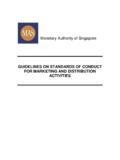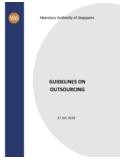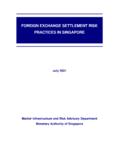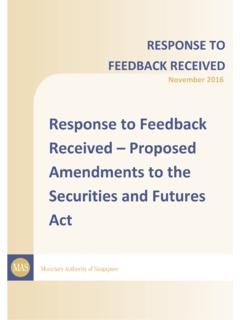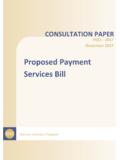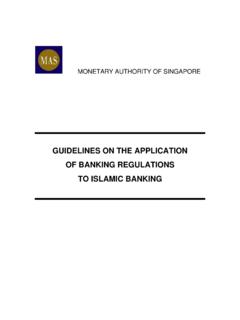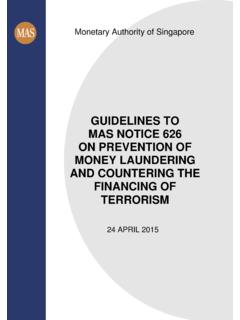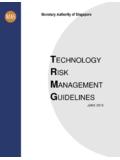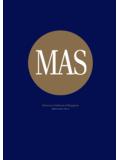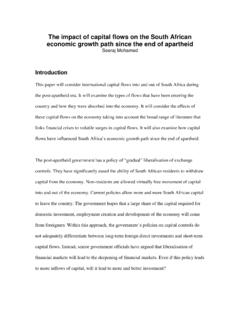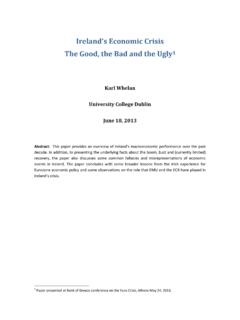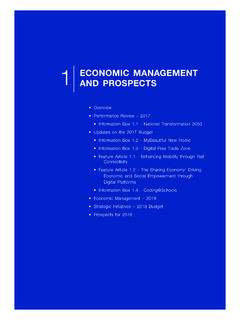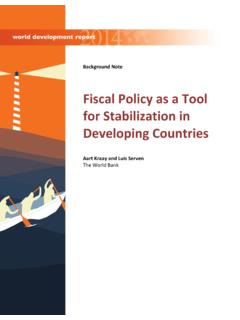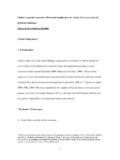Transcription of LIQUIDITY RISK - Monetary Authority of Singapore …
1 [TYPE Monetary Authority of Singapore Monetary Authority of Singapore Monetary Authority of Singapore Monetary Authority of Singapore Monetary Authority of Singapore Monetary Authority of Singapore Monetary Authority of Singapore Monetary Authority of Singapore Monetary Authority of Singapore Monetary Authority of Singapore Monetary Authority of Singapore Monetary Authority of Singapore Monetary Authority of Singapore Monetary Authority of Singapore Monetary Authority of Singapore Monetary Authority of Singapore Monetary Authority of Singapore Monetary Authority of Singapore Monetary Authority of Singapore Monetary Authority of Singapore Monetary Authority of Singapore Monetary Authority of Singapore Monetary Authority of Singapore Monetary Authority of Singapore Monetary Authority of Singapore Monetary Authority of Singapore Monetary Authority of Singapore Monetary Authority of Singapore Monetary Authority of Singapore LIQUIDITY RISK March 2013 GUIDELINES ON RISK MANAGEMENT PRACTICES MARCH 2013.]
2 LIQUIDITY RISK Monetary Authority OF Singapore Table of Contents 1 Introduction 1 2 fundamentals 1 3 Principles for Sound LIQUIDITY Risk Management 2 Application of Guidelines 2 Governance 2 Strategies, Policies and Procedures 2 Measurement and Management of LIQUIDITY Risk 3 Contingency Funding Plan 4 Stress Testing and Scenario Analysis 4 Foreign Currency Management 4 Asset Encumbrance 4 Checklist of Sound Practices to Adopt I GUIDELINES ON RISK MANAGEMENT PRACTICES MARCH 2013 - LIQUIDITY RISK Monetary Authority OF Singapore 1 1 INTRODUCTION These guidelines provide guidance on sound LIQUIDITY risk management practices.
3 The extent and degree to which an institution adopts these guidelines should commensurate with the size, nature and complexity of its activities. 2 fundamentals LIQUIDITY risk refers to the risk of an institution being unable to meet its financial obligations as they fall due without incurring unacceptable costs or losses through fund raising and assets liquidation. It could be a result of the inability of the financial institutions to manage unplanned decreases or changes in funding sources and the failure to recognise or address changes in market conditions that affect the institution s ability to liquidate assets quickly and with minimal loss in value.
4 LIQUIDITY risk often arises from other forms of financial risk such as credit and market risks . Real or perceived problems in any business area may hinder an institution's ability to raise funds at reasonable prices, thereby increasing LIQUIDITY risk. For example, large credit losses due to loan defaults could cause LIQUIDITY problems for an institution if providers of funding were to become concerned about the impact of the losses on the institution s creditworthiness. For insurers, the nature of their business typically results in a lower exposure to LIQUIDITY risk compared with banks.
5 However, perceived reputational issues with a life insurer may result in large surrenders over a short period that require the insurer to liquidate assets at depressed prices. For general insurers, even though their policies do not have cash values, a series of large claims over a short period may still result in LIQUIDITY shortfalls. Therefore, an institution s consideration of LIQUIDITY risk should capture all risk factors that it is exposed to, and it must manage these risks soundly. A LIQUIDITY crisis could have a negative impact on earnings and capital and, in the extreme, cause the collapse of an otherwise solvent institution.
6 Earnings and growth potential could be negatively affected if an institution s LIQUIDITY position constrains it from undertaking a transaction at normal market prices. An institution should have a strategy to manage its LIQUIDITY risk prudently and adequately. The strategy should take into account the institution s risk profile, risk appetite as well as market and macroeconomic conditions. Policies and processes should be established to support the GUIDELINES ON RISK MANAGEMENT PRACTICES MARCH 2013 - LIQUIDITY RISK Monetary Authority OF Singapore 2 execution of this strategy and ensure compliance with the LIQUIDITY requirements.
7 These should cover the identification, measurement, evaluation, monitoring, reporting and control or mitigation of LIQUIDITY risk over an appropriate set of time horizons. 3 PRINCIPLES FOR SOUND LIQUIDITY RISK MANAGEMENT Application of Guidelines This section outlines the key principles for sound LIQUIDITY risk management. Institutions should also take into account relevant regulatory requirements and industry standards such as the Basel Committee on Banking Supervision Principles for Sound LIQUIDITY Risk Management and Supervision published in September 2008, where appropriate.
8 Insurers should adopt the principles and sound practices provided in these guidelines to the extent applicable to the nature of their business. Governance An institution should consistently observe prescribed LIQUIDITY requirements. An institution should assess its LIQUIDITY risk profile (including on- and off-balance sheet risks ) in the context of the markets and macroeconomic conditions in which it operates. An institution should have a robust LIQUIDITY management framework that requires maintaining sufficient LIQUIDITY to withstand a range of stress events.
9 This includes appropriate policies and processes for managing LIQUIDITY risk that have been approved by the institution s Board of Directors ( Board ). These policies and processes should also provide a comprehensive institution-wide view of LIQUIDITY risk and are consistent with the institution s risk profile. Strategies, Policies and Procedures An institution should have LIQUIDITY strategies, policies and processes that establish an appropriate and properly controlled LIQUIDITY risk environment including: (a) clear articulation of an overall LIQUIDITY risk appetite that is appropriate for the institution s business and its role in the financial system and that is approved by its Board.
10 GUIDELINES ON RISK MANAGEMENT PRACTICES MARCH 2013 - LIQUIDITY RISK Monetary Authority OF Singapore 3 (b) sound day-to-day and intraday LIQUIDITY risk management practices; (c) effective information systems to enable active and timely identification, aggregation, monitoring and control of LIQUIDITY risk exposures and funding needs (including active management of collateral positions) institution-wide; (d) adequate oversight by the institution s Board in ensuring that management effectively implements policies and processes for the management of LIQUIDITY risk in a manner consistent with the institution s LIQUIDITY risk appetite.
